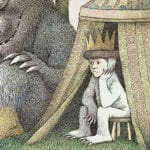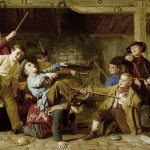 Mysteries
Mysteries  Mysteries
Mysteries  History
History 10 Surprising Stories About the Texas Rangers
 Humans
Humans 10 Philosophers Who Were Driven Mad by Their Own Theories
 Miscellaneous
Miscellaneous 10 Video-Game-Worthy Weapons and Armors from History
 Weird Stuff
Weird Stuff 10 Psychics Who Accurately Predicted Wartime Events
 The Arts
The Arts 10 Pieces of Art Inspired by a Broken Heart
 Health
Health 10 Science Fiction-Sounding New Medical Treatments
 History
History 10 Surprising Facts About the Father of Submarine Warfare
 Space
Space Ten Astonishing New Insights into Alien Worlds
 Weird Stuff
Weird Stuff 10 Bizarre Summer Solstice Rituals Still Practiced Today
 Mysteries
Mysteries Top 10 Haunting Facts About the Ghost Ship MV Alta
 History
History 10 Surprising Stories About the Texas Rangers
 Humans
Humans 10 Philosophers Who Were Driven Mad by Their Own Theories
Who's Behind Listverse?

Jamie Frater
Head Editor
Jamie founded Listverse due to an insatiable desire to share fascinating, obscure, and bizarre facts. He has been a guest speaker on numerous national radio and television stations and is a five time published author.
More About Us Miscellaneous
Miscellaneous 10 Video-Game-Worthy Weapons and Armors from History
 Weird Stuff
Weird Stuff 10 Psychics Who Accurately Predicted Wartime Events
 The Arts
The Arts 10 Pieces of Art Inspired by a Broken Heart
 Health
Health 10 Science Fiction-Sounding New Medical Treatments
 History
History 10 Surprising Facts About the Father of Submarine Warfare
 Space
Space Ten Astonishing New Insights into Alien Worlds
 Weird Stuff
Weird Stuff 10 Bizarre Summer Solstice Rituals Still Practiced Today
Ten of the Most Disturbing Children’s Books
The children’s books on this list are about as far from Goodnight, Moon as you can get. Forget cozy tales of friendly animals and gentle life lessons. Today, we’re exploring a few books that are unsettling at best. The themes they explore go way beyond spooky tales. These narratives touch on complex emotions, existential questions, and societal reflections, challenging the conventional expectations of what constitutes appropriate material for young readers.
You’ll find protagonists facing everything from alcoholism and assault to Satanic rituals. And yes, we’re still talking about books for kids here. The illustrations can be pretty unsettling, too.
In this compilation of 10 disturbing children’s books, prepare for these picks to linger long after you turn the last page. These are the stories that will make you question the boundaries of childhood innocence.
Related: Top 10 Terrifying Children’s Movies
10 Don’t Make Me Go Back, Mommy by Doris Sansford
Apparently, in the ’80s and ’90s, Satanists loved working in daycare centers. At least that’s one of the many creepy themes this messed-up book gives off. Sansford published Don’t Make Me Go Back, Mommy in 1990 in a series of books to help kids cope with difficult subjects. But it’s honestly a wonder how a book like this ever made it to shelves in the first place, no matter the decade.
When a little girl named Allison is subjected to horrific rituals during her time at daycare, she learns to heal through therapy. But here’s the kicker—Sansford did months of research to make sure that the rituals were accurate. Yes, Doris, kids really want to know the straight facts about Satanic abuse. Apparently, the book was even referenced in the book The Therapist’s Notebook for Children and Adolescents in 2003.
Thank goodness the general approach to trauma and abuse recovery for children has changed so much in the past decade. Hopefully, this book can stay hidden on a dusty shelf where it belongs.
9 Alfie’s Home by Richard A. Cohen
It’s crazy to think that someone out there actually thought, “You know what the world needs? A children’s book about sexual abuse and conversion therapy.” How could that possibly go wrong?
“Oh no! It all went wrong!”
Cohen’s book Alfie’s Home follows a young boy who is sexually assaulted by his uncle. If you can believe it, there’s actually an illustration depicting them in bed together. And the narrative is disturbing on so many levels. Then, the boy spends years grappling with his own sexuality. Since he believes he is gay, his parents put him in therapy. During his sessions, he is suddenly “cured” of his homosexuality with a single hug from his dad. There’s probably a really good chance this book caused a lot more problems than it helped.
Cohen claims the fictional children’s book to be “proof” that homosexual people can change. But in a 2017 interview with Rachel Maddow, she stated, “Richard Cohen is not licensed by any American or any other licensing body whatsoever.” Hopefully, no child is ever subjected to this book.
8 A Day No Pigs Would Die by Robert Newton Peck
Considered a classic, this 1972 novel was one of the first to be classified as young adult literature. While it’s not quite a children’s book, it definitely deserves a spot on the list.
A Day No Pigs Would Die is partially an autobiography detailing Peck’s childhood in rural America. The book explores themes of life and death, usefulness, and hard work. It also touches on religion and animal husbandry. While a lot of the book’s themes can certainly be seen as disturbing, they’re also just a part of living. And that’s what makes this book a great way to help kids process some of the disturbing things that happen in life.
7 Children Are No Match for Fire by Carol Dean
The intentions of this book are good… if only that was all that mattered. Carol Dean’s vintage book, Children Are No Match for Fire, sets out to give children a healthy fear of fire. But perhaps she takes it a bit too far?
We have to start out by mentioning the cover, where two young children are running from a floating match, candle, and lighter. Oh, and all of them are lit. We’ll let that disturbing image sink in while we talk about the actual story.
Jodi and John are twins who take a class on fire safety from the local fire department, learning how to stop, drop, and roll. But their skills are put to the test at their birthday party, where only they can save the day. The only question I have here is… where are the adults in all this?
6 I Wish Daddy Didn’t Drink So Much by Judith Vigna
Surprisingly, this book has pretty good reviews. Used in the right setting, it could be a good resource for helping kids deal with the effects of alcoholism in their families. But it certainly wouldn’t be a book you would want kids picking off the shelves themselves for a bedtime read.
The book talks subtly about AA meetings and how her father’s habit is so hurtful to their family. The girl is also able to confront her father about his problem and express her frustration. There’s also an author’s note that addresses alcoholism, explaining what it is and why it’s an issue.
There’s a major downside, though. This book doesn’t exactly have a happy ending. The girl’s father doesn’t recover or even seek help. In some ways, this book could be good therapy for kids dealing with these issues, but it could also leave them feeling a little hopeless.
While the book is aimed at younger children, thanks to the illustration style, it’s probably better suited to kids 14 and up.
5 Hiroshima No Pika by Toshi Maruki
This is one book that, while it is disturbing, you should absolutely still consider reading. In fact, this story would be a fantastic conversation started between parents and children. While this is historical fiction, it’s an accurate depiction of how the atomic bomb affected families in Hiroshima, Japan. Maruki did her research, interviewing survivors who could share their experiences.
Maruki’s book Hiroshima No Pika was published in 1981. It helps to describe the physical and emotional pain that the bomb caused. One thing to be aware of beforehand is that the illustrations are graphic in their own way. In the aftermath of the bomb, some characters are drawn in the nude, and bodies are depicted as warped. Some critics recommend the book for children older than eight, though the book is written for children specifically.
4 Maggie Goes on a Diet by Paul M. Kramer
To any kid who was subjected to this 2011 book, you never should have had to experience that. In an attempt to address weight issues in children, Kramer wrote Maggie Goes on a Diet. This book is about an overweight girl who goes on a diet and loses lots of weight. She finally becomes happy and feels accepted as a “normal” girl.
While Kramer’s attempt was (somewhat) noble, this approach has the complete opposite effect to what he planned. If you really want your kids to develop body dysmorphia and hate the skin they’re in, this is the book for you.
3 If a Peacock Finds a Pot Leaf by Morgan Carman
You’ve seen lots of books and shows encouraging kids not to do drugs, right? Well, I bet you’ve never seen a book that gives kids reasons why they should. Morgan Carman’s book If a Peacock Finds a Pot Leaf was published in 2013. It follows Pete the Peacock, who stumbles on a pot leaf in the forest. Thankfully, he has his trusty animal friends to teach him all about the benefits of medical marijuana.
Believe it or not, this isn’t even Peter Peacock’s first trip into the world of drugs. This is actually the last book in a series of pro-drug books that includes If a Peacock Discovers Hemp Island.
2 Where Willy Went… The Big Story of a Little Sperm! by Nicholas Allan
Nobody likes giving their kids “the talk.” Children’s book author Nicholas Allan has set out to make reproduction fun for kids of all ages. Where Willy Went follows a tiny sperm named Willy who competes against lots of other sperm for the big prize—an egg. The book shows how the baby grows and develops inside a mom’s tummy. Be aware that it also shows rough sketches of a man and woman’s genitals to explain where Willy lives and where he’s going.
I think the appeal of this 2006 book is probably a 50/50 split. A lot of parents would find turning the sex talk into a bedtime story to be pretty disturbing. But every household is different. Some parents prefer to be a lot more open and frank with discussions like this than others. In fact, a parent poll from Planned Parenthood stated that “57 percent said they only feel somewhat comfortable or uncomfortable talking to their children about sex and sexual health.”
So, if you fall under the group that doesn’t mind sharing these open and honest discussions, this book might be a great tool for your family. If you don’t, I wouldn’t suggest checking this one out from your local library.
1 The Lonely Doll by Dare Wright
This book deserves its spot as number one on this list. The concept of a story like this is probably better suited to a horror movie than a place in children’s literature.
Released in 1957, The Lonely Doll includes a series of staged photos of a doll named Edith who lives alone. She longs for friends until two stuffed bears show up. While the older Mr. Bear is away, Edith and the smaller bear set out to explore and get themselves into trouble. In the end, Mr. Bear decides she needs to be punished for being bad. He flips her over his knee and spanks her.
The images and story are disturbing. But that may have been intentional since Wright used the book as an artistic outlet to deal with her childhood trauma and odd relationship with a very controlling mother.
Wright published several more books in the Lonely Doll series and completed a total of 20 books for children. While the book doesn’t seem like it belongs anywhere near a nursery, many women have found connection and healing through this unique take on childhood.








